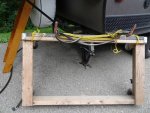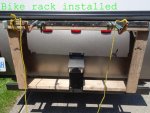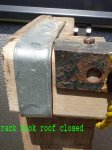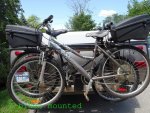Paul Brubacher
In Memoriam
- Messages
- 296
- Location
- outside of Toronto, Ont
We're preparing for another camping trip with our tent trailer and I've been wondering how to take bikes along. There are special adapters that allow hitch mount bike racks to be added to a standard hitch, but with 400 lbs of hitch weight already this is not an option. The trailer weighs about 2200 lbs.
Even using the roof racks on the trailer would add substantially to the hitch weight because the racks are at the very front of the roof. I've been thinking of moving them further to the rear but am concerned about the warranty.
That leaves the racks on the Santa Fe, which could be an option since they could be moved to the front of the vehicle.
So I looked up some prices and the special racks to hold the bikes are from 100 to 300 dollars for each bike. This is more than we paid for the bikes, so why not make them out of wood?
It shouldn't be difficult to fasten a bolt or threaded rod that can be used to fasten the front forks, but I'm not certain what kind of clamp to use for the rear wheel. The ones that I've seen are basically strong tie wraps with a button for releasing.
Would a simple notched wooden bar with bolts and wing nuts be sufficient to hold the rear wheel?
Any other ideas would be appreciated.
P.s. Even with the 400 lbs hitch weight there is no problem with the handling of the vehicle even though it is above the rated load. It probably helps that we keep the back area empty of heavy objects.
Sometimes there is wheel spin when starting on uneven roads. (Front wheel drive).
The only time that there was any instability was once when passing a tanker trailer truck. The vehicle started to wobble.
Even using the roof racks on the trailer would add substantially to the hitch weight because the racks are at the very front of the roof. I've been thinking of moving them further to the rear but am concerned about the warranty.
That leaves the racks on the Santa Fe, which could be an option since they could be moved to the front of the vehicle.
So I looked up some prices and the special racks to hold the bikes are from 100 to 300 dollars for each bike. This is more than we paid for the bikes, so why not make them out of wood?
It shouldn't be difficult to fasten a bolt or threaded rod that can be used to fasten the front forks, but I'm not certain what kind of clamp to use for the rear wheel. The ones that I've seen are basically strong tie wraps with a button for releasing.
Would a simple notched wooden bar with bolts and wing nuts be sufficient to hold the rear wheel?
Any other ideas would be appreciated.
P.s. Even with the 400 lbs hitch weight there is no problem with the handling of the vehicle even though it is above the rated load. It probably helps that we keep the back area empty of heavy objects.
Sometimes there is wheel spin when starting on uneven roads. (Front wheel drive).
The only time that there was any instability was once when passing a tanker trailer truck. The vehicle started to wobble.








